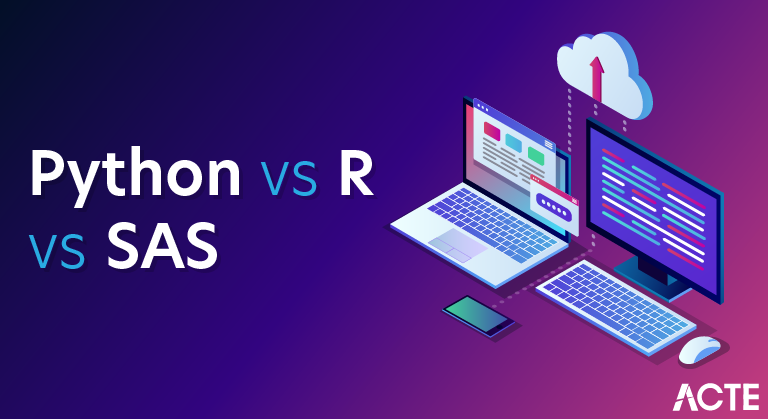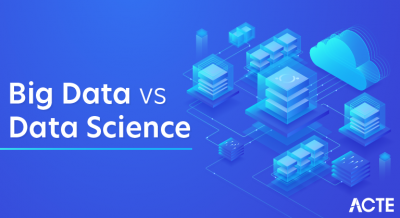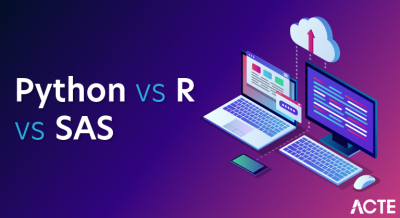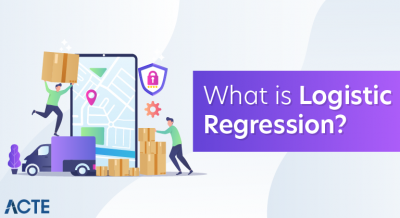
In this topic, we are going to compare all the three languages on various aspects to give you a clear perspective about market value and capabilities of these languages, so that you can choose the language with that you can move forward.
It is a well-known fact that to learn data analysis, you can use three important languages that are Python, R, and SAS.
If you are a fresher in the data science community and do not have experience in any of the languages mentioned above, then it is vital to be acquainted with at least one language.
SAS
SAS is the integrated system of software solutions and it is the leader in the data analytics field. This software has a lot of features like good GUI and others to provide awesome technical support. SAS helps you to do the following tasks
- Data Entry, retrieval and management
- Report writing and graphics design
- Statistical and mathematical analysis
- Business Forecasting and decision support
- Operations Research and Project management
- Applications development
SAS is used by reputed companies like Barclays, Nestle, HSBC, Volvo and BNB Paribas.
R
R is a programming language for statistical computing and graphics which was created in the year 1995 by Ross Ihaka and Robert Gentleman. It offers a wide range of statistical and graphical techniques. It is a open source route which is highly extensible. It is a simple and effective programming language. It is more than just a statistics system. It does the following work
- Easily manipulates packages
- Manipulates strings
- Works with regular and irregular time series
- Visualize data
- Machine learning
R is used by top rated companies like Bank of America, bing, Ford, Uber and Foursquare.
Python
Python is a object oriented programming language that has a clear syntax and readability. It was created in 1991 by Guido Van Rossem. It is easy to learn and will help you work more quickly and effectively. It has become more popular in a short period of time because of its simplicity.
Python is used by famous companies like ABN-AMRO, Quora, Google and reddit.
Reasons for comparison
- Industries are growing dynamically. As the field grows there are a lot of technological advancements in each language.
- If you are new to the data analytics field then you might be learning a new one because of your interest or most of the times driven by what your organization works with.
- You might challenges and frustrations because of upgrades in the tools and software programs.
- Comparison of the languages is a worthy consideration now. Any comparison which was done before few years will not be relevant to the current situation. Comparisons will also help in choosing the best among the three.
- These languages are compared on the following factors in this article. You may not purchase a tool based on the following comparisons but it will definitely be useful for you to choose one which suits your career.
SAS vs R vs Python?
There has never been a conclusive answer to the question of which is better SAS vs R vs Python?
All three technologies have situations where they excel while lacking in some. What tool one chooses should be based on the person’s requirements. We have made comparisons among them based on the following points:
- Ease of learning
- Data handling ability
- Data visualization
- Cost-effectiveness
- Customer service and community support
- Updates
- Market demand
1. Ease of Learning
- SAS is probably the easiest to learn of all three. It has a good GUI that makes it even easier to learn and use. To effectively use SAS, one needs to know SQL beforehand.
- R has the steepest learning curve among these. It is a low-level language, so it requires more code for simpler tasks.
- Without prior knowledge of effective coding practices, the code can be even messier and longer to accomplish the simplest of tasks.
- Python is known for its flexibility and simplicity. It doesn’t have a widespread GUI, but Python notebooks are becoming popular. Python is a high level, object-oriented language, and is easier to learn than R.
- When it comes to learning, SAS is the easiest to learn, followed by Python and R.
2. Data Handling Ability
- Data is increasing in size and complexity every day. A data science tool must be able to store and organize large amounts of data effectively.
- SAS is smooth and stable when it comes to handling data on stand-alone machines.
- R works only on RAM, this makes working with large datasets very slow. It does have packages like plyr and Dplyr that make data handling much easier in R.
- We can also integrate R with Hadoop, which makes distributed data storage and processing possible.
- Python has libraries like Panda and NumPy that make data handling extremely easy.
- As base packages or with added extensions, all three can handle large data effectively.
3. Data Visualization
- SAS can plot graphs and render basic graphs, but its data visualization capabilities are merely functional.
- R excels at data visualization with packages like ggplot2, plotly, Rvis, Rgis, etc.. It is the best tool for data visualization.
- Python has extensions like matplotlib and seaborn that make creating custom graphs easy.
- R is the clear winner for data visualization.
- SAS is proprietary software. It is highly expensive and out-of-reach for individuals and small and medium-sized organizations.
- While there is a free university edition available, it has limited features.
- R is open-source. Anyone can use it and contribute to it. Many startups and large-scale organizations as well, use R.
- Python is also an open-source language. Students, as well as professionals, can use it for free.
- R and Python being open-source have an advantage over SAS in terms of cost-effectiveness.
- SAS has dedicated customer support that helps with all issues about installation and usage. However, due to its cost, the community is not that large.
- R does not have a dedicated customer service team, but it does have a massive community. The R community has people from almost all industries and from all over the world.
- A solution for any issue can be provided by the large community.
- Python is also open-source, and therefore, it also has a large community. However, Python’s popularity has increased in recent years and, thus, the community is not as large as R’s.
- While SAS may have dedicated customer support, it’s community pales in comparison with that of R’s pr Python’s.
- SAS only gets updated at every new version rollout. However, the SAS team includes new features after thorough testing, and they have almost no errors.
- R and Python are open-source. Anybody can add new features with new packages and extensions. They receive the latest updates faster.
- R and Python get the latest updates much faster, and anybody can contribute towards it.
- While SAS was the global leader in available corporate jobs in data analytics earlier. The scenario has changed in recent years.
- More and more companies are opting for open-source technologies creating more job openings for people with skills like R and Python. Large corporations like Ford use R along with Hadoop for data analysis. They require professionals with skills in such technologies.
- Apart from data science, web and software development industries also use Python and hire professionals with skills in it.
- SAS was a global leader in corporate jobs for data analysis. But now, the open-source technologies have taken over. We expect the job opportunities for R and Python to keep increasing.
- We see the market slightly bending towards Python in today’s scenario. It will be pre-mature to place bets on what will prevail, given the dynamic nature of industry.
- Depending on your circumstances (career stage, financials etc.) you can add your own weights and come up with what might be suitable for you. Here are a few specific scenarios:
- If you are a fresher entering in analytics industry (specifically so in India), I would recommend to learn SAS as your first language. It is easy to learn and holds highest job market share.
- If you are some one who has already spent time in industry, you should try and diversify your expertise be learning a new tool.
- For experts and pros in industry, people should know at least 2 of these. That would add a lot of flexibility for future and open up new opportunities.
- If you are in a start-up / freelancing, R / Python is more useful.
- Strategically, corporate setups that require more hands-on assistance and training choose SAS as an option.
- Researchers and statisticians choose R as an alternative because it helps in heavy calculations. As they say, R was meant to get the job done and not to ease your computer.
- Python has been the obvious choice for startups today due to its lightweight nature and growing community. It is the best choice for deep learning as well.
For aspiring Data Scientists, the plethora of tools can make it difficult for you to make the right choice.
We discussed three most popular tools – R, Python, and SAS. However, what is the right tool for you as a beginner in Data Science? In this section, we will address this query and give you the right answer based on your needs and expectations.
1. Choosing the right learning curveWhile R will take some time for you to gain proficiency, Python provides an easier learning curve that is best suited for beginners who are not only newbies in data science but also in programming. Since Python is a versatile language, you can use it for developing web-applications as well.
When it comes to SAS, it is an environment for programming that is designed for statisticians with little focus on complicated syntax. This means that it is easy to learn SAS. However, it is easy in order to implement complex statistical thinking efficiently and with ease.
2. Cost and expenses of the toolsBoth Python and R are open-source. Anyone can use them without any need to purchase licenses. However, with SAS it is an entirely different story.
SAS is a closed-source proprietary tool that is highly expensive. The costs of it are so high such that only big companies can afford to purchase this tool.
Also, many more attributes and features of SAS can be unlocked through payment of expensive upgrades. Therefore, if you are a newbie in Data Science, learning SAS may not be an ideal choice from the cost perspective.
3. Libraries and Support toolsBoth Python and R enjoy a wide range of packages. Python is famous for its wide variety of packages on machine learning.
It also provides versatile packages of web-development, GUI programming and much more. R is limited only to packages of statistical modeling.
However, the visualization packages of R such as ggplot2, Lattice, RGIS are much more diverse and visually aesthetic. SAS on the other hand, provides a wide variety of Business Intelligence, Statistical, and analytics tools.
However, it still lags behind in more advanced tools of machine learning and data visualization.
4. What do Industries require?Industries have long trusted SAS as their primary tool for data analytics and business intelligence. This is due to high reliance, sophistication and stability that SAS provides to its clients.
However, gradually, the trend is shifting to Python, R and other open-source libraries that provide far more powerful features than SAS. While SAS may be ideal for large scale industries who have not adapted open-source as their primary tool, it is still not flexible as other free alternatives.
Prior to 2015, SAS used to dominate the data science industry, however, by 2017, it became a minority to Python and R.
5. Tool for the right needIn the end, the choice of learning Python, R and SAS depend on their usage and where you need to apply them. For beginners who want to learn a programming language while enjoying a wide variety of libraries, Python is an ideal language.
For seasoned statisticians, R is an ideal language. Both of these languages provide extensive open-source support and you can customize their packages on your own. For data scientists, seeking careers in the field of natural language processing, visual computing, and big data, Python and R are the ideal programming languages. However, for statisticians seeking employment in companies that specialize in business intelligence, SAS is the right choice.






